
Hyde Memorial State Park
Introduction
Hyde Memorial State Park is located 8 miles from Santa Fe on New Mexico State Highway 475 (Hyde Park Road to the Santa Fe Ski Basin) in the southwestern Sangre de Cristo Mountains. This 350-acre park has picnic facilities and several trails that lead into the Santa Fe National Forest, which surrounds the park. Elevations in the park range from ~8400 to 9200 feet.
.jpg)
© 2012 Thomas Shahan, Wikimedia Commons
Regional Geologic History
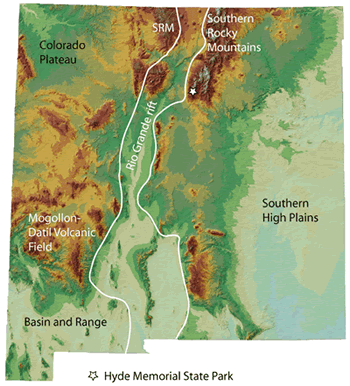
Hyde Memorial State Park (Figure 1) lies in the southwestern Sangre de Cristo Mountains in the Santa Fe Range. The north-south trending Sangre de Cristo Mountains are about 225 miles long, extending from near Salida, Colorado, at the north end to just southeast of Santa Fe at the south end (Bauer, 2008). The Sangre de Cristo Mountains are considered to be part of the Southern Rocky Mountain physiographic province (Figure 2). The mountains rise abruptly from the relatively topographically subdued High Plains on the east side. The Rio Grande rift, a northerly-trending zone of continental extension that runs from northern Colorado to west Texas, marks the western boundary of the range. The Santa Fe Range, which is cored by Proterozoic basement rocks, is bound on the north by the Peñasco embayment, on the south by Glorieta Pass, on the west by the Española Basin, and on the east by the Picuris-Pecos Fault just west of the Pecos River. At least four episodes of mountain building are recorded in the Sangre de Cristo Mountains.
Geology of the Santa Fe Range
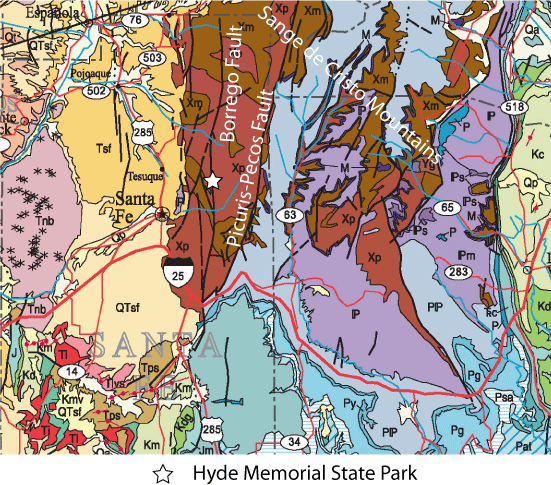
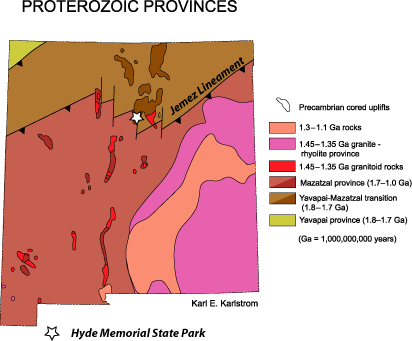
The oldest rocks in the Sangre de Cristo Mountains are Proterozoic metavolcanic and metasedimentary rocks, which are preserved in several places throughout the range (Xm on Figure 3), including along NM Highway 475 to the west of the park (Bauer et al., 1996; Bauer, 2008). These rocks originally were volcanic rocks (basalts and rhyolites) and sandstone deposited in a basin about 1.72 to 1.65 billion years ago. These volcanic and sedimentary rocks were buried, deformed, and heated during a mountain building event about 1.65 billion years ago (Figure 4) related to the southward growth of the North American as island arcs were accreted onto the southern margin of the continent (Bauer, 2008; Karlstrom et al., 2004). The combination of high temperatures and high pressures at great depth in the Earth transformed the volcanic and sedimentary rocks into metavolcanic and metasedimentary rocks. Later, 1.60 to 1.65 billion year-old granitic rocks pervasively intruded into the older metamorphic rocks. The Santa Fe Range lies just north of a profound crustal boundary known as the Jemez lineament (Figure 4) that marks the southern extent of 1.7 billion year old rocks in New Mexico (Karlstrom et al., 2004).
Hyde Memorial State Park is underlain by three slightly different types of 1.65 billion year old pink to red granite (Bauer et al., 1996). Granite is a coarse-grained igneous rock that cooled deep in the Earth that is made up mostly of quartz and pink orthoclase feldspar, with minor amounts of biotite, chlorite, magnetite, zircon, apatite, and allanite (Xg on Figure 5). In some places, particularly on the west side of the park, the granite is unusually quartz-rich, containing up to 40% quartz crystals (Xqp of Figure 5). The granite on the east side of the park contains abundant biotite, a black micacous mineral (Xbg on Figure 5). All three types of granite are foliated (i.e, the platy mica minerals like biotite are aligned), which means that these rocks were deformed in the roots of the 1.6 to 1.65 billion year old mountain range after the granitic magmas were emplaced. The granite was later brecciated by motion along the Borrego fault zone at shallow levels in the crust (Figure 6, top photo).

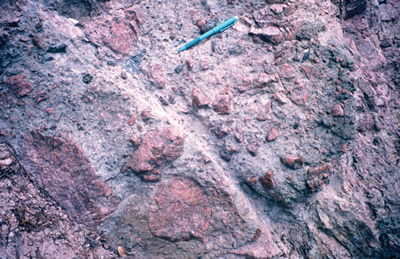
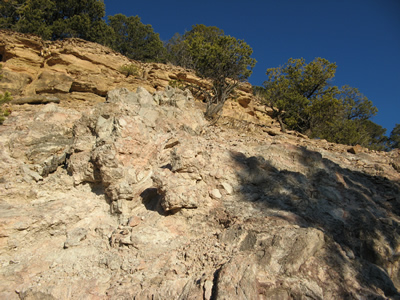
By 340 million years ago, the deeply buried Proterozoic rocks were back at the Earth's surface, where they were covered by rocks deposited in a shallow ocean during late Mississippian time. Mississippian dolomite, limestone, sandstone, and shale overlie granite along the eastern range front (Read et al., 2000). One exposure can be seen on a sharp curve (Nun's Curve) on Highway 475 just north of the Ten Thousand Waves resort (Figure 6, bottom photo). Here Mississippian dolomite and shale sit on highly fractured and weathered granite. This is a classic example of the Great Unconformity. Approximately 1.34 billion years of Earth's history is missing across this boundary! Mississippian rocks are only spottily preserved in the Santa Fe Range. In places the Mississippian rocks are missing and Pennsylvanian rocks that were deposited in a shallow ocean rest directly on the Proterozoic granite.

Starting about 315 million years ago, the area now occupied by the Santa Fe Range was on the southeastern margin of an Ancestral Rocky Mountain highland called the San Luis uplift (Figure 7; Baltz and Myers, 1999; Kues and Giles, 2004). Ancestral Rocky Mountain deformation across the southwestern United States is characterized by north- and northwest-trending uplifts separated by intervening basins that are filled with both marine sediments and sediments shed from the adjacent uplifts. Detritus eroded from the San Luis mountain range was shed eastward into a basin east of the Picuris-Pecos fault. This phase of mountain building waned about 280 million years ago (Baltz and Myers, 1999).
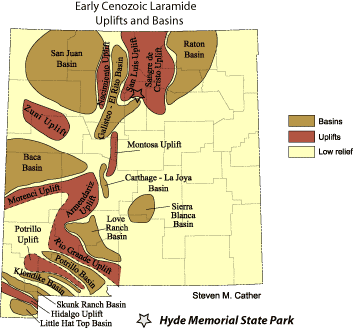
The Santa Fe Range was likely tectonically quiet between 280 and ~70 million years ago and was probably covered by the Cretaceous Western Interior Seaway; however, any rocks deposited during this time interval have since been removed by erosion during subsequent mountain building events. Starting about 70 million years ago, a significant compressive mountain building event, the Laramide orogeny, caused the Santa Fe Range to rise again (Figure 8). Thrust faults are present on the west side of the range, north of Highway 475 (Read et al., 2004).
The Borrego Fault zone occupies the north-south trending canyon that runs through Hyde Memorial State Park (Figures 4 and 5). This fault zone is a significant northerly-trending fault zone that bisects the Santa Fe Range, running from the southern tip of the range at I-25 to Borrego Mesa on the north edge of the Santa Fe Range (Figure 2). Some geologists suggest that the Picuris-Pecos and Borrego fault zones were significant right-lateral strike-slip faults during Laramide deformation (e.g., Cather, 1999; Cather et al., 2005), while others think that Laramide strike-slip faulting was relatively minor (Erslev et al., 2004). The Borrego Fault zone could have been active during Ancestral Rockies deformation, too.
The final tectonic event to affect the Sangre de Cristo Mountains was Rio Grande rift extension, starting about 26 million years ago. In contrast to the Sangre de Cristo Mountains adjacent to the San Luis Basin near Alamosa, Colorado, and Taos, New Mexico, where large down-to-the-west normal faults on the west side of the range control the modern topography the Sangre de Cristo Mountains, large normal faults are not present on the western margin of the Santa Fe Range. Did the Santa Fe Range attain most of its present topographic relief during Laramide deformation? Was the Santa Fe Range originally part of the Española rift basin (Kelley et al., 1992; Smith, 2004) that subsequently was uplifted along the Picuris-Pecos fault on the east side of the range during late stages of rifting (Smith, 2004)? Ongoing research is attempting to answer these questions.
References
- Baltz E.H, and Myers, D.A., 1999, Stratigraphic framework of upper Paleozoic rocks, southeastern Sangre de Cristo Mountains, New Mexico, with a section on speculations and implications for regional interpretation of Ancestral Rocky Mountains paleotectonics: New Mexico Bureau of Mines and Mineral Resources Memoir 48, 272 pp.
- Bauer, P.W., 2008, Chapter 16. The Southern Sangre de Cristo Mountains in Price, G., editor, Parks and Monuments of Northern New Mexico: New Mexico Bureau of Geology and Mineral Resources Publication, in press.
- Bauer, P.W., Ralser, S., Daniel, C., Ilg, B., 1996, Geology of the McClure Reservoir 7.5-min quadrangle, Santa Fe County, New Mexico: New Mexico Bureau of Mines and Mineral Resources, Open-file Geologic Map OF-GM 7, scale 1:12,000. with mineral resource evaluation by M. Fulp.
- Cather, S.M.., 1999, Implications of Jurassic, Cretaceous, and Proterozoic piercing lines for Laramide oblique-slip faulting in New Mexico and rotation of the Colorado Plateau: Geological Society of America Bulletin, v. 111, p. 849-868.
- Cather, S.M., Timmons, J.M., and Karlstrom, K.E., 2005, Regional inferences for the 1.4 Ga–Holocene lateral slip history of the Picuris–Pecos and related faults, northern New Mexico: New Mexico Geological Society, Guidebook 56, p.93–104.
- Erslev, E.A., Fankhauser, S.D., Heizler, M.T., Sanders, R.E., and Cather, S.M., 2004, Strike-slip tectonics and thermochronology of northern New Mexico: A field guide to critical exposures in the southern Sangre de Cristo Mountains, in Nelson, E.P., and Erslev, E.A., eds., Field trips to the southern Rocky Mountains, USA; Geological Society of America Field Guide 5, p. 15–40.
- Karlstrom, K.E., Amato, J.M., Williams, M.L., Heizler, M., Shaw, C., Read, A., and Bauer, P., 2004, Proterozoic tectonic evolution of the New Mexico region: a synthesis, in Mack, G.H. and Giles, K.A., editors, The Geology of New Mexico: A Geologic History: New Mexico Geological Society Special Publication 11, p. 1-34.
- Kelley, S.A., C.E. Chapin, and J. Corrigan, 1992, Late Mesozoic to Cenozoic cooling histories of the flanks of the northern and central Rio Grande rift, Colorado and New Mexico: New Mexico Bureau of Mines and Mineral Resources Bulletin 145, 39 pp.
- Kues, B.S., and Giles, K.A., 2004, The late Paleozoic Ancestral Rocky Mountains System in New Mexico, in Mack, G.H. and Giles, K.A., editors, The Geology of New Mexico: A Geologic History: New Mexico Geological Society Special Publication 11, p. 95-136.
- Read, A.S., Koning, D.J., Smith, G.A., Ralser, S., Rogers, J., Bauer, P.W., 2000, Geology of the Santa Fe 7.5-min. quadrangle, Santa Fe County, New Mexico, New Mexico Bureau of Mines and Mineral Resources, Open-file Geologic Map OF-GM 32, scale 1:12,000.
- Smith, G.A., 2004, Middle to Late Cenozoic development of the Rio Grande rift and adjacent regions in northern New Mexico, in Mack, G.H. and Giles, K.A., editors, The Geology of New Mexico: A Geologic History: New Mexico Geological Society Special Publication 11, p. 331-358.
- Wilks, M.E., compiler, 2005, New Mexico Geologic Highway Map: New Mexico Geological Society and New Mexico Bureau of Geology and Mineral Resources, scale1:1,000,000.



